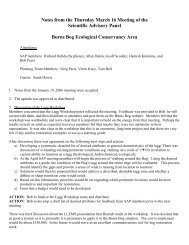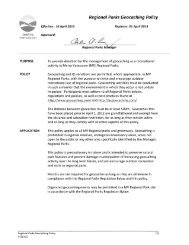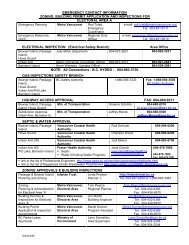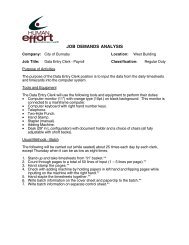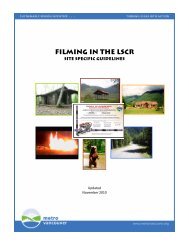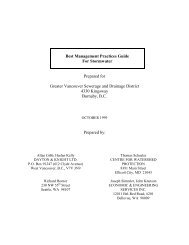Physical Job Demands Analysis - Truck Driver 2 ... - Metro Vancouver
Physical Job Demands Analysis - Truck Driver 2 ... - Metro Vancouver
Physical Job Demands Analysis - Truck Driver 2 ... - Metro Vancouver
Create successful ePaper yourself
Turn your PDF publications into a flip-book with our unique Google optimized e-Paper software.
JOB DEMANDS ANALYSIS<br />
Company: Corporation of Delta Location: Works Yard<br />
<strong>Job</strong> Title: <strong>Truck</strong> <strong>Driver</strong> 2/3 Crane/HIAB Classification: Regular Duty<br />
Purpose of Activities<br />
The <strong>Truck</strong> <strong>Driver</strong> 2/3 Crane/HIAB drives and operates a ten speed Tandem axle truck with<br />
a 5.5 metre open deck and a six ton HIAB boom crane. The <strong>Truck</strong> <strong>Driver</strong> 2/3 will pick-up<br />
and deliver tools, equipment and product in the Fraser Valley, North <strong>Vancouver</strong>, <strong>Vancouver</strong><br />
and Delta.<br />
Tools and Equipment<br />
The <strong>Truck</strong> <strong>Driver</strong> 2/3 will use the following tools and equipment to perform his duties:<br />
• Clothing – Steel Toe boots, hard hat, gloves, safety vest<br />
• Ten Speed Tandem Axle <strong>Truck</strong> (air brakes) with a 5.5 metre open deck<br />
• Six ton HIAB boom crane<br />
• Chains, tie down straps, cheaters, blocks, lifting straps, stakes<br />
• Small hand tools (hook, hammer, shovel, etc.)<br />
Usual Methods<br />
The <strong>Truck</strong> <strong>Driver</strong> 2/3 Crane/HIAB will perform a pre-trip vehicle inspection every morning.<br />
This will include greasing the truck, checking and topping up fluid levels, checking air brakes,<br />
tire pressure and ensuring all lights are in working order. The truck is then used to pick up<br />
and deliver tools, equipment and materials to and from a work site or vendor.<br />
Loading<br />
1. Drive to loading location (work site, works yard, vendor.)<br />
2. Maneuver the truck into position beside the load. Check area for overhead wires or<br />
other obstructions. Exit truck.<br />
3. Pull out stabilizers for Crane/HIAB (64-kg force required) by hand. Use controls to level<br />
truck with stabilizers.<br />
4. Operate Crane/HIAB controls to maneuver the boom over the load. The controls are<br />
located on either side of the truck.<br />
5. Place the lifting straps through the load. Hook the lifting straps to the lifting ring on the<br />
Crane/HIAB boom. Operate the Crane/HIAB controls to lift the load from the ground<br />
onto the truck deck. Position the load on the truck deck with the Crane/HIAB.<br />
6. Climb up to the truck deck (1.5 m, three ladder steps).<br />
7. Unhook the lifting straps from the load.
8. Climb down from the truck deck. Return the Crane/HIAB boom to the travelling<br />
position.<br />
9. Secure the load to the truck with chains, straps and stakes. Chains and straps may be<br />
thrown over the load to the far side of the truck deck. The <strong>Truck</strong> <strong>Driver</strong> 2/3 may have to<br />
climb up onto the truck deck to secure the chains or straps over the load. Climb down<br />
from the truck deck.<br />
10. Use a cheater to tighten the load down to the truck deck.<br />
11. Use the controls to lift the stabilizers off the ground. Push in the stabilizers for the<br />
Crane/HIAB (64-kg force required) by hand.<br />
12. Return the lifting straps to storage.<br />
13. Climb back into the cab of the truck.<br />
14. Drive the truck to drop off location.<br />
Unloading<br />
1. Maneuver the truck into position to unload the cargo. Check the area for overhead wires<br />
or other obstructions. Exit the truck.<br />
2. Pull out the stabilizers for the Crane/HIAB (64-kg force required) by hand. Use the<br />
controls to level the truck with the stabilizers.<br />
3. Operate the Crane/HIAB controls to maneuver the boom over the load. The controls<br />
are located on either side of the truck.<br />
4. Remove the tie down straps from over the load. Use a cheater if required. Roll up the<br />
straps and place in storage.<br />
5. Grab the lifting straps from the storage bin; climb up to the truck deck (1.5m from the<br />
ground, three ladder steps).<br />
6. Place the lifting straps through the load. Hook the lifting straps to the lifting ring on the<br />
Crane/HIAB boom.<br />
7. Climb down from the truck deck.<br />
8. Operate the Crane/HIAB controls to lift the load off the truck deck to the ground.<br />
Position the load on the ground with the Crane/HIAB.<br />
9. Unhook the lifting straps from the load. Put the lifting straps in the storage bin. Return<br />
the Crane/HIAB boom to the travelling position.<br />
10. Use the controls to lift the stabilizers off the ground. Push in the stabilizers for the<br />
Crane/HIAB (64-kg force required) by hand.<br />
11. Climb into the cab of the truck.<br />
12. Drive the truck to the next pick-up location.<br />
In some instances the cargo may be loaded on or unloaded off the truck deck by a forklift, if<br />
one is available.<br />
The presence of ** indicates non-value added tasks. These tasks do not<br />
contribute to the stated purpose of the work.<br />
Administrative Issues<br />
The <strong>Truck</strong> <strong>Driver</strong> 2/3 Crane/HIAB works an eight hour day, Monday to Friday from 0800 to<br />
1630 with a ten-minute rest period in the morning, a 30-minute lunch break and a ten-minute<br />
rest period in the afternoon. Overtime and on-call are not requirements of this position.<br />
The truck is equipped with power steering, air brakes, fully adjustable air ride drivers seat, a<br />
ten speed split shift gearbox and a six-ton HIAB boom crane. The <strong>Truck</strong> <strong>Driver</strong> 2/3<br />
estimates that he travels up to 200 kilometres per day in the Fraser Valley, North
<strong>Vancouver</strong>, <strong>Vancouver</strong> and Delta. The <strong>Truck</strong> <strong>Driver</strong> 2/3 Crane/HIAB usually works alone.<br />
However, a Labourer will be provided on request.<br />
Activity Demand Variables<br />
These variables are tasks that must be carried out by the employee and are implicitly or<br />
explicitly required as objectives of the job.<br />
• Sit to drive and operate the <strong>Truck</strong><br />
• Climb approximately 1.3 metres (two steps) to get in and out of the truck cab<br />
• Climb three ladder steps to 1.5 metres to get on and off the truck deck<br />
• Crouch, kneel, bend and stoop to grease and perform Pre-trip Inspection on truck and<br />
Crane/HIAB every morning<br />
• Bend, stoop, crouch, kneel to put chains or lifting straps through load<br />
• Stand on ground to operate Crane/HIAB controls<br />
• Twist spine to operate Crane/HIAB controls and keep visual contact with load<br />
• Reach below and above shoulders to drive the truck, operate Crane HIAB controls,<br />
secure load to truck and remove load from the truck<br />
• Drive the truck through traffic in the Fraser Valley, North <strong>Vancouver</strong>, <strong>Vancouver</strong> and Delta<br />
Worker Decision Variables<br />
These variables are the sub-routines and cognitive/physical decisions made by the worker<br />
in carrying out the objectives of the job.<br />
• Sitting posture (neutral spine, shoulders, elbows slightly open, hips above knees are<br />
the desired postures)<br />
• Take frequent rest breaks from sitting and static grip forces required to operate the truck<br />
Accommodative Considerations<br />
1. Class 3 license with air brake endorsement is required to drive the tandem axle truck.<br />
2. People with injuries to the spine, in any region, may have difficulty with the static and<br />
dynamic movements required drive and operate the truck and Crane/HIAB.<br />
3. People with shoulder injuries such as rotator cuff tendonitis, bursitis and instability may<br />
have difficulty with dynamic and static loading and reaching activities required to drive the<br />
truck, operate the Crane/HIAB controls and secure the load to the truck.<br />
4. People with nerve compression injuries in the right upper extremity may have difficulty<br />
with shifting gears and steering the vehicle.<br />
5. Post-whiplash and other neck problems may have difficulty with this position.<br />
6. People with hip and lower extremity injuries may have difficulty climbing in and out of the<br />
truck cab (two steps to 1.3 metres from the ground) and on and off the truck deck (1.5<br />
metres from the ground, three ladder steps).<br />
Prepared By: Jeffrey J. McGinn, Kinesiologist May 20, 1999
Metabolic Stresses<br />
Summary of Stresses<br />
The aerobic energy system will provide the major source of energy for the <strong>Truck</strong> <strong>Driver</strong> 2/3<br />
Crane/HIAB. This position is primarily sedentary with low level energy expenditure while<br />
driving the truck, operating the Crane/HIAB and loading and unloading cargo on the truck<br />
deck. It is not likely that the anaerobic energy system will be required to provide energy for<br />
the <strong>Truck</strong> <strong>Driver</strong> 2/3 Crane/HIAB.<br />
Structural Stresses<br />
Spine – The sedentary nature of this work can place significant passive loads on the spinal<br />
structures. Prolonged sitting increases disc compression forces. A flexed spine sitting<br />
posture requires no activity from the torso musculature, but increases asymmetrical disc<br />
compression and passive stretch on the posterior ligaments and disc fibres. This forward<br />
flexed posture can contribute to disc integrity problems over time as well as decondition the<br />
torso support musculature. This passive stretch on the ligaments (ligament creep)<br />
destabilizes the spine and any maximal lifting, carrying, pushing or pulling (securing the load<br />
to the truck) immediately after prolonged sitting will increase the risk of injury.<br />
During Crane/HIAB operation, the <strong>Truck</strong> <strong>Driver</strong> 2/3 is required to rotate (static or concentric<br />
contraction) left and/or right to maintain visual contact with the load. These movements will<br />
increase asymmetrical compression on the discs increasing the risk of injury<br />
Neck, Shoulders and Upper Extremities – Due to the static positions required and the<br />
frequent reaching for the steering wheel and gear shift, the muscles in the rotator cuff of the<br />
shoulder (especially right) and the upper trapezius and scalene muscles of the neck,<br />
maintain significant and often constant static load. Resting the left elbow on the driver’s side<br />
window will have the same negative effect as described above. Also, if the <strong>Truck</strong> <strong>Driver</strong><br />
2/3 Crane HIAB is too low in his seat with respect to the steering wheel, gear shift and<br />
driver’s side window, the load on the neck and shoulders is increased as the arms must be<br />
lifted and held in a static position to steer the truck and shift gears. Constant use of the trucks<br />
side mirrors, specifically when maneuvering the truck, will increase the static tension in the<br />
upper trapezius and scalene muscles as well.<br />
Hips and Lower Extremities – Prolonged sitting is likely to shorten the hamstring muscle<br />
group of both legs. This in turn will pull the pelvis under the body and prevent the <strong>Truck</strong><br />
<strong>Driver</strong> 2/3 Crane /HIAB from sitting on the sit bones (Ischeal Tuberosity) and promote the<br />
undesirable forward flexed spinal posture. Slip and fall injuries while getting in or out (two<br />
steps to 1.3 metres) of the truck cab and on and off the truck deck (three ladder steps to 1.5<br />
metres) are increased during wet weather of wet working conditions.
INTERVENTIONS<br />
Recommendations that could be implemented to increase productivity and lessen the risk<br />
of injury are listed below:<br />
1. Teach the <strong>Truck</strong> <strong>Driver</strong> 2/3 Crane/HIAB to set up the adjustable seat to adopt neutral<br />
sitting postures (hip angle, spine, shoulders, elbows and wrists) which will decrease the<br />
risk of injury to the spine and upper extremities.<br />
2. Encourage the <strong>Truck</strong> <strong>Driver</strong> 2/3 Crane/HIAB to maintain an increased level of fitness<br />
away from work that will focus on cardiovascular endurance, muscular strength, muscular<br />
endurance and flexibility.<br />
3. Install a remote Crane/HIAB boom control that can be operated away from the truck.<br />
This will decrease the right and left spinal rotation and allow for neutral postures when<br />
operating the Crane/HIAB.
PJDC-TD 2/3 Crane HIAB<br />
Referral: Cathy Cook Organization: Corporation of Delta Title: <strong>Truck</strong> <strong>Driver</strong> 2/3 Crane/HIAB<br />
Dept.: Engineering Division: Roads/Traffic Contact:Pete Jokish<br />
FREQUENCY* Date: May 4, 1999<br />
R S Max. Usual<br />
E I Sel Low Mod High Weight Weight<br />
PHYSICAL DEMANDS Q D (kg) (kg) COMMENTS<br />
D E 1 2 3 4<br />
Lifting - Floor to Knuckle X D X 20
PJDC-TD 2/3 Crane HIAB<br />
Referral: Organization: Title: see 1st page header<br />
Dept.: Division: Contact:<br />
FREQUENCY* Date:<br />
R S<br />
E I Sel. Low Mod. High<br />
PHYSICAL DEMANDS Q D COMMENTS<br />
D E 1 2 3 4<br />
Hearing - Conversations X X cell phone, crews, supervisors, shipper/receivers<br />
P Hearing - Other Sounds X X cell phone, vehicle traffic<br />
E Vision - Far X X drive truck, operate crane/HIAB, tie down/untie load<br />
R Vision - Near<br />
C Vision - Colour X X traffic lights<br />
E Vision - Depth X X drive truck in traffic, operate crane/HIAB<br />
P Perception - Spatial X X drive truck in traffic, operate crane/HIAB<br />
T Perception - Form<br />
I Feeling (Tactile) X X operate crane/HIAB controls, use cheater to tie down load<br />
O Reading X X street signs, maps, job list<br />
N Writing X X pick-up/delivery orders<br />
Speech cell phone, crews, supervisor, shipper/receivers<br />
Inside Work X X in cab of truck, possibly in some buildings<br />
Outside Work X X operate crane/HIAB , tie down/untie load<br />
Hot Conditions >25 deg. C X X spring, summer, fall, no air conditioning in truck<br />
Cold Conditions 3 hrs daily<br />
The following shading denotes a HIGH RISK TASK: Modifications should be considered<br />
REQD is marked with an X if the particular demand or category is relevant to the purpose of the job.<br />
SIDE refers to the side or limb required to execute a task. If it is marked E, it indicates either side, the most common choice<br />
is listed first. D refers to dominant and B to both sides.<br />
For detailed descriptions of each of the different categories, please refer to the reference guide or inquire with<br />
Human Effort at 1-888-4EFFORT<br />
© Human Effort 1999<br />
Page 2



